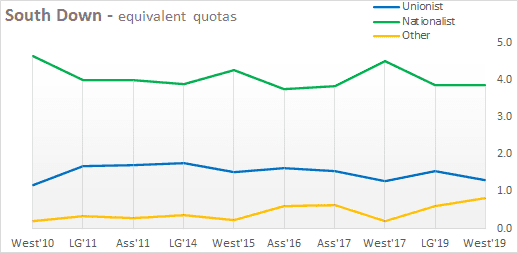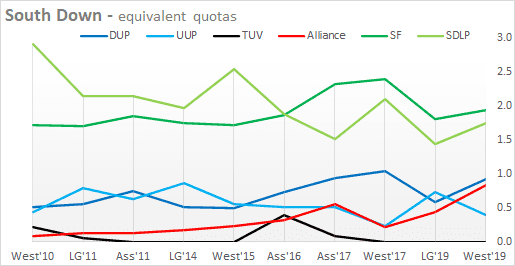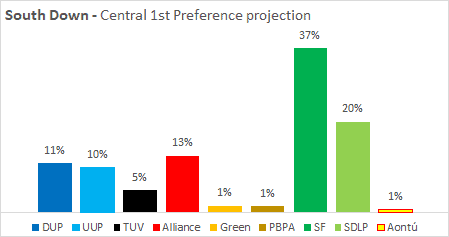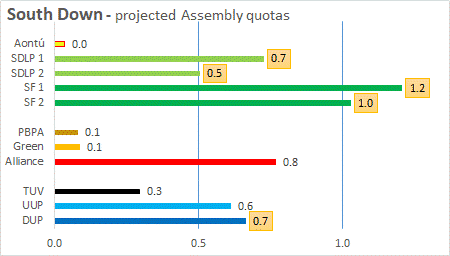Note that I have used the most recent Lucid Talk poll for my projection of party shares in the constituency.
The tactical voting by some unionists and others for the SDLP in South Down, which boosted the nationalist share at Westminster elections, appears to have disappeared by 2019.

South Down is another one of those places where candidates from outside of the constituency’s main parties sometimes win significant numbers of votes. In the 2019 Local Government elections, these would have been worth a full quota. So, it is important to take both the designation and party charts together.

This largely means that there are no conclusions to be drawn from the uplift in SF and SDLP votes in the last Westminster election which largely came from Independent nationalists. However, there still appears to have been significant tactical voting by UUP supporters for the DUP.
My estimate is that the Westminster vote pattern would have produced 2 SF, 2 SDLP and 1 from a Unionist party.
My Central projection of the Lucid Talk poll suggests a pattern like that below.

Which would mean that quotas per candidate might look something like this. Seats won in 2017 are highlighted in gold.

SF and SDLP votes are divided between their candidates in the same proportions as 2017.
There is also one Independent standing, Patrick Clarke, a former Slieve Croob Independent Councillor, previously of Alliance and before that the SDLP.
All three of my projections agree that there would be 2 SF and 1 SDLP Safe seats. Beyond that, there are quite a range of possibilities.
The Central projection has Alliance also Safe, with the final seat being either the UUP or DUP with equally Good possibilities.
One of the other projections also has Alliance Safe with the UUP and DUP both having a Good possibility of taking the final seat.
In the third projection, there would come a point at which the second SDLP, Alliance and UUP candidates would be likely to be very close, with one of them facing elimination. If the second SDLP is unlucky the final two seats go to Alliance and the UUP. If the UUP exits then they go to Alliance and the DUP, and if Alliance falls out then the second SDLP and the UUP have them.
On none of these projections does the TUV get a look in. Unless, of course, the controversies surrounding the DUP candidate selection and the public backing of the TUV candidate by Jim Wells persuade a substantial proportion of DUP voters to switch. Seems unlikely, but nevertheless one to watch.
NOTE ON METHOD:
There is no perfect way to translate a national poll to a local constituency level. Still less so in a PR system. We must recognise a level of uncertainty. I have used the last Lucid Talk poll as my base for party shares, and information from the previous poll which tracked how voters for each party at the last Assembly election intend to vote this time. This allowed me to make two projections for each constituency, one based on vote switching since 2017, the other on changes in party vote shares since the 2019 Local Government elections. (I used the LG elections due to widespread tactical voting at the later Westminster.) To be clear both of these projections give the party shares shown in the latest poll.
The two different projections mimic two different patterns of changes in party support. In one, a party that is growing strongly will see a bit less of that growth where it is already strong, and a bit more where it was previously at it most weak. Conversely the parties that have lost voters will suffer a bit more in their strongest constituencies.
The other projection has the opposite effect. Either may prove to be a more accurate reflection of reality. And while the differences between the two are not massive (they both must total to the same poll shares across all constituencies) they can still sometimes produce different outcomes.
I should stress that while the Lucid Talk bears the responsibility for the original poll, the projections are entirely my responsibility.
For each 1st preference projection, I have used recent transfer patterns to identify all candidates who have any chance of winning on a scale ranging from Safe to Long Shot.
To avoid burdening you with all this detail I have averaged the results of the two projections and shown them as a Central projection, merely noting where one of the other projections produces a noteworthy difference.
Where a party is running more than one candidate, I have generally split the party vote between them in the same proportions at the last election. I have had to make my own assumptions when a party has a different number of candidates this time.
Michael Hehir is a retired sales and marketing manager. He studied in Northern Ireland but now lives between England and Italy.
Discover more from Slugger O'Toole
Subscribe to get the latest posts to your email.
